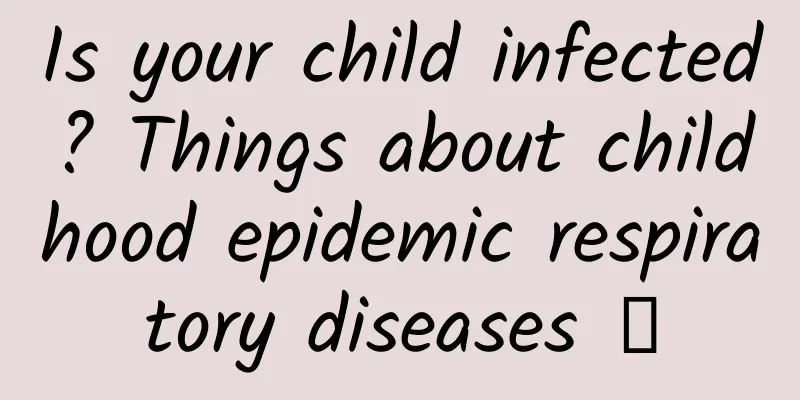Is your child infected? Things about childhood epidemic respiratory diseases →

|
Influenza (abbreviated as "flu") is the most common epidemic respiratory disease. It is an acute respiratory infectious disease caused by influenza virus. Influenza is divided into four types: A, B, C, and D, depending on the influenza virus that infects. Currently, the main influenza A subtypes that infect humans are the H1NI and H3N2 subtypes, and the Victoria and Yamagata strains of the influenza B virus. What symptoms should you be highly suspicious of having the flu? The flu generally manifests as: (Specific symptoms vary from person to person) (1) Obvious systemic symptoms (such as sudden fever, body temperature up to 39-40°C, headache, muscle and joint pain, fatigue, chills, fear of cold, loss of appetite, etc.); (2) Mild respiratory symptoms (including sore throat, dry cough, nasal congestion, runny nose, discomfort behind the sternum, etc.) After getting the flu, how do you tell whether it is influenza A or influenza B? Whether it is influenza A or influenza B, they are both influenza viruses and it is generally difficult to distinguish them based on symptoms. If a clear diagnosis is to be made, influenza virus antigen or nucleic acid testing is required. Influenza virus antigen testing is fast, but less sensitive than nucleic acid testing. A positive viral antigen test supports the diagnosis, but a negative test does not rule out influenza. Viral nucleic acid testing has high sensitivity and specificity, and can distinguish between viral types and subtypes. How do children's flu symptoms differ from those of adults? When children get influenza, their fever is usually higher than that of adults. They are more likely to have digestive tract symptoms such as nausea, vomiting, and diarrhea when they have influenza B. Newborns may only experience symptoms such as excessive sleep, refusal to feed, and respiratory arrest. Children with influenza are more likely to have laryngitis, otitis media, and bronchitis than adults. What symptoms should indicate suspected mycoplasma infection? The main symptoms are fever (moderate to high fever, body temperature > 38.5℃ ), paroxysmal dry cough, and severe cough , which may be accompanied by headache, runny nose, sore throat, earache, chest tightness, chest pain, etc. Some children may experience wheezing and dyspnea, which are more common in infants and young children. The total white blood cell count and neutrophil ratio in a blood routine test are generally normal, but a few may be elevated. In clinical practice, many children experience fever and dry cough. Repeated blood tests and mycoplasma-related tests are all normal. Can mycoplasma infection be ruled out? Mycoplasma grows slowly and is difficult to culture in vitro, so currently blood tests for mycoplasma-related antibodies are the main means of diagnosing mycoplasma infection. Mycoplasma antibodies are divided into IgG and IgM . IgG antibodies rise later and last longer. IgM antibodies can appear 3 to 5 days after infection and reach a peak 3 weeks after infection, which is more meaningful for diagnosing early mycoplasma infection. However, for some people who suffer from repeated mycoplasma infections, IgM may remain negative. Therefore, even if mycoplasma IgM is negative for multiple times, mycoplasma infection cannot be ruled out . However, false positives may also occur, and doctors need to make a comprehensive judgment based on clinical manifestations, tests, and chest imaging. How can children prevent epidemic respiratory diseases (influenza A, influenza B, mycoplasma infection)? Influenza (A and B) and mycoplasma infection are both respiratory diseases and their prevention measures are similar. (1) Vaccination Influenza vaccination is the most effective means of preventing influenza. Children aged 6 months to 5 years, and family members and caregivers of children under 6 months old are given priority for influenza vaccination every year. (2) General preventive measures Maintaining good personal hygiene habits is an important means of preventing respiratory diseases, including washing hands frequently, keeping the environment clean and ventilated, reducing activities in crowded places during the peak season of respiratory diseases, and avoiding contact with patients with respiratory infections; maintaining good respiratory hygiene habits, covering your mouth and nose with your upper arm or a tissue or towel when coughing or sneezing, washing your hands after coughing or sneezing, and try to avoid touching your eyes, nose or mouth; wearing a mask when going to public places or seeking medical treatment. Author: Chen Ying Doctor of Traditional Chinese Medicine Respiratory Medicine, Beijing Hepingli Hospital, attending physician Editor: Dong Xiaoxian |
<<: What is the "Disease X" that the WHO has repeatedly warned about? | BoLan Daily
>>: Have you ignored visual fatigue?
Recommend
Lumbar disc herniation! Back pain! Huaxi doctors teach you these tips to protect your waist! Simple and cost-effective
Other people's resume: Outstanding academic p...
"Henan Health" 24 Solar Terms · Minor Heat丨Midsummer is here, check out the "cool" measures to prevent heatstroke while it's hot
As the saying goes, "Minor Heat and Greater ...
Vital capacity standard for college girls
However, many young girls, that is, college stude...
I didn't have my period but I was bleeding
As a woman, it is actually very easy to encounter...
Is the acupuncture breast enhancement patch real or fake?
Acupuncture is a traditional Chinese medicine tre...
Menstruation is late and there is a dull pain in the stomach
Most female friends have experienced delayed mens...
What should I do if there is a gestational sac in the retroverted uterus?
Women should be very familiar with the uterus, be...
Important reminder! 9 important points to note when doing antigen self-test
recently In response to some netizens' questi...
An eye disease that is particularly easy to ignore: Eyelid entropion in children
What you don't know about pathological eye pl...
Does mastitis require surgery?
The chance of mastitis occurring in women who hav...
Is the rate of fetal preservation high for threatened miscarriage?
In the early stages of pregnancy, many pregnant w...
What does it feel like for a girl to be addicted to smoking?
In today's society, many women smoke, but aft...
Why do women sweat on their feet?
Normally, your feet don't sweat easily. Howev...
Can I eat coffee beans during my period?
Menstruation is something every woman has to go t...
Can my aunt eat mutton?
Women during menstruation should pay attention to...









